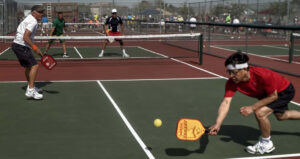 One sport that has grown rapidly in popularity among our clients at Back to Function is pickleball. A combination of tennis, badminton and ping-pong, pickleball is a fun and social sport, which is one reason it’s so popular. The rules are simple and the game is easy for beginners to learn, but can develop into a fast-paced, competitive game. A report from the Sports & Fitness Industry Association showed a 113.1% increase in pickleball participation from 2020 to 2022, and in December, Sports Illustrated called it the the fastest-growing sport in America.
One sport that has grown rapidly in popularity among our clients at Back to Function is pickleball. A combination of tennis, badminton and ping-pong, pickleball is a fun and social sport, which is one reason it’s so popular. The rules are simple and the game is easy for beginners to learn, but can develop into a fast-paced, competitive game. A report from the Sports & Fitness Industry Association showed a 113.1% increase in pickleball participation from 2020 to 2022, and in December, Sports Illustrated called it the the fastest-growing sport in America.
Who is Playing Pickleball?
Seniors make up about one third of the 22.3 million people expected to play pickleball this year. Given that pickleball requires a lot of quick stopping and changing directions in a population that has a higher number of older participants, there are many opportunities for injuries. In fact, older adults account for a whopping 85 percent of reported pickleball injuries, according to a May 2021 study in Injury Epidemiology. Americans will spend between $250 million and $500 million in healthcare costs related to pickleball injuries this year.
In order to decrease the number of injuries that are occurring with pickleball, participants need to be better prepared for the vigors of the sport.
Below we will outline the most common injuries that are occurring in pickleball, as well as prevention exercises and treatment strategies for each of them.
Ankle Sprain
 Pickleball requires quick direction changes from side to side. If you feel your ankle “roll over” causing intense ankle pain and almost immediate swelling on the outside of your ankle and foot, then you have a sprained ankle. Most often, when you turn your ankle, you only do damage to the soft tissue structures like the ligaments that stabilize the outside of your foot/ankle. Anyone can sprain an ankle, but you’re more likely to do it if your ankle is weak and unstable.
Pickleball requires quick direction changes from side to side. If you feel your ankle “roll over” causing intense ankle pain and almost immediate swelling on the outside of your ankle and foot, then you have a sprained ankle. Most often, when you turn your ankle, you only do damage to the soft tissue structures like the ligaments that stabilize the outside of your foot/ankle. Anyone can sprain an ankle, but you’re more likely to do it if your ankle is weak and unstable.
Note: you can sprain the ligaments on the inside of the ankle, but this is less common.
Prevention of an ankle sprain should include strengthening the muscles on the side of your leg and hip (gluteus medius and peroneals) which can help your ankle stabilize during quick direction changes. Below are a few exercises that will help (in order of easiest to more difficult):
T-Hold
Patrick Step Progression
1-Foot Mini Squat Hold with Plate Drive
Slantboard Skater Squat
Hop Turn & Spin
Treatment of an ankle sprain should include elevation of the leg, soft tissue therapy, compression bands/sleeves/splints and interferential therapy to reduce the pain and swelling. Joint mobillization/manipulation of the foot and ankle can help restore the normal range of motion of the joints as this often is an issue after ankle sprain. As soon as possible, exercises are added to restore normal motion of the ankle. Most ankle sprains can be back to normal in 1-3 weeks if treated properly.
Expert Tip: We DO NOT apply ice to ankle sprains (see article entitled Is the Use of Ice for Soft Tissue Injuries Actually a Bad Idea?).
Plantar Fasciitis
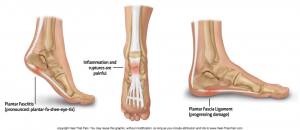 The plantar fascia is a connective tissue ligament that connects your heel bone to your toes and acts as a shock-absorbing bowstring supporting the arch of your foot. The plantar fascia is designed to absorb the forces we place on our feet when walking or navigating the pickleball court. When this connective tissue is strained, the area can become swollen and inflamed creating pain at the bottom of your foot when standing or walking. Repetitive foot loading, unsupportive shoes and tight calf muscles can all strain the plantar fascia and increase your risk of pain.
The plantar fascia is a connective tissue ligament that connects your heel bone to your toes and acts as a shock-absorbing bowstring supporting the arch of your foot. The plantar fascia is designed to absorb the forces we place on our feet when walking or navigating the pickleball court. When this connective tissue is strained, the area can become swollen and inflamed creating pain at the bottom of your foot when standing or walking. Repetitive foot loading, unsupportive shoes and tight calf muscles can all strain the plantar fascia and increase your risk of pain.
Prevention of plantar fasciitis should include a gradual increase in pickleball activity. If you are new to the sport, limit your on-court activity for the first few months and slowly ramp up your time on the court as well as your intensity. Make sure you are wearing good supportive shoes. Too many people use shoes that are older and broken down and then are surprised when their feet hurt. Replace your shoes every 6 months. Below are some exercises that can help alleviate tight calf muscles and decrease the stress on the plantar fascia:
Expert Tip: A good postural assessment can determine if you are loading your feet abnormally, which can contribute to plantar fasciitis.
Sumo Squat/Hip Raise/Down Dog/Knee Flexion
Golf Ball Roll
Calf Stretch
Treatment of plantar fasciitis includes a temporary reduction in activities, soft tissue therapy, chiropractic adjustments of the ankle joint and foot, stretching techniques and postural restoration. The use of night splints, orthotics for arch support and heel cups/pads may also be helpful. In conjunction with this treatment, exercises to strengthen the calf muscles and arch of the foot are also recommended.
Tennis Leg
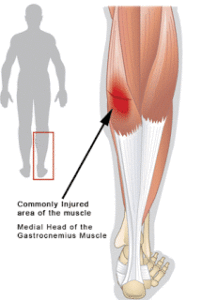 The typical complaint is the athlete feels a sudden pain in the calf and may feel that they have been struck by an object. The pickleball player will feel that they have been hit by the ball or racket in the calf area. That is the painful sensation of part of the calf muscle tearing. The athlete may experience pain and weakness when trying to stand on tip toes. Bruising and swelling at the back of the leg are common. The athlete might have difficulty moving the ankle and knee due to the calf pain and tightness.
The typical complaint is the athlete feels a sudden pain in the calf and may feel that they have been struck by an object. The pickleball player will feel that they have been hit by the ball or racket in the calf area. That is the painful sensation of part of the calf muscle tearing. The athlete may experience pain and weakness when trying to stand on tip toes. Bruising and swelling at the back of the leg are common. The athlete might have difficulty moving the ankle and knee due to the calf pain and tightness.
Prevention of tennis leg includes gradual increase in duration and intensity of play (similar to plantar fasciitis prevention strategy) and an adequate warm up strategy. Simply showing up at the court and playing is not smart and is an easy way to end up with injuries like a tennis leg! Try these warm up exercises to help prevent a calf injury:
Calf Stretch & Sumo Squat/Hip Raise/Down Dog/Knee Flexion (see above)
3D Stretch Lunge
Slant Board Stretch
Calf Raise Progression
Treatment of tennis leg includes compression, elevation and movement.
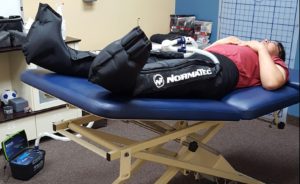
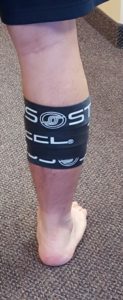
Compression – Use compression of the injured area in the form of bands, sleeves, compression clothing etc.. At BTF, we like to use the NormaTec as a passive form of compression that helps with lymphatic drainage. We also use compression bands (also called Voodoo bands because of their “magic” healing properties).
Elevation – This is a helpful way to assist with lymphatic drainage. Try to get the injured calf elevated as many times per day as possible with the addition of compression to speed your recovery.
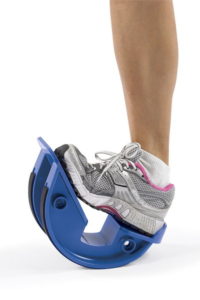
Movement – If it is too painful to walk then crutches may be beneficial as partial weight bearing is recommended. Full weight bearing and walking normally should be done as soon as pain allows. Mobility exercises and gentle calf stretching should be started as soon as possible. As soon as normal walking is pain free then strengthening exercises should begin.
Tennis Elbow
T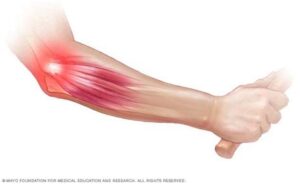 ennis elbow is a burning, deep achy pain affecting the fleshy part on the outside of the elbow. It’s technical name is lateral epicondylitis. Tennis elbow is an overuse injury. If you do some activity that requires frequent wrist extension (the motion your wrist does when you lift your fingers up towards the sky) or wrist pronation (the motion your wrist does when you turn your hand from palm-up to palm-down), then you may get tennis elbow. Pickleball requires lots of wrist extension and pronation!
ennis elbow is a burning, deep achy pain affecting the fleshy part on the outside of the elbow. It’s technical name is lateral epicondylitis. Tennis elbow is an overuse injury. If you do some activity that requires frequent wrist extension (the motion your wrist does when you lift your fingers up towards the sky) or wrist pronation (the motion your wrist does when you turn your hand from palm-up to palm-down), then you may get tennis elbow. Pickleball requires lots of wrist extension and pronation!
Prevention of tennis elbow includes gradual increase in duration and intensity of play (similar to tennis leg prevention strategy) and an adequate warm up strategy. Simply showing up at the court and playing is not smart and is an easy way to end up with injuries like a tennis elbow! Try these warm up exercises to help prevent an elbow injury:
Physioball Forearm Stretch
Shoulder Diagonals
Hanging Overhead Reach
Banded Dumbell Oblique Raise
Kettlebell L-Rotation to Vertical Press
Treatment of tennis elbow starts with a visit with one of our doctors at BTF so we can examine your elbow. We will palpate around the area and stretch affected muscles, ask you to resist certain motions, and feel the texture of the involved structures to see if they feel leathery, grainy, or don’t move the way they should. We will even examine your wrist, shoulder and neck to make sure that your elbow pain isn’t being caused by a compensatory type of injury. Your BTF doctor can use his/her hands to break up the scar tissue, increase oxygen delivery, lengthen the contracted muscles and tendons, free any entrapped nerves, get the myofascial structures moving the specific ways they should and help you to strengthen them so they stay that way. Another treatment option that we have available at BTF is shockwave therapy, which is highly effective at treating tennis elbow.
Shockwave Therapy For Tennis Elbow
Maybe one of the most important things you can do to help prevent injuries on the pickleball court, is to properly warm up prior to playing. Check out Dr. Matt’s warm up sequence he uses prior to running with his dogs!
As with any fitness program, you should check with your healthcare provider before trying any of these exercises. If you need help with a pickleball injury, or would like to prevent an injury and improve your fitness, please give us a call at 310-534-1900 or email us at info@backtofunction.com.
FEEL – RECOVER – PERFORM BETTER
References:
Learn to Play Pickleball. usapickleball.org
‘Pickleball Is the Wild, Wild West’: Inside the Fight Over the Fastest-Growing Sport in America



